SWRR History
In the late 1970’s, volunteers dedicated to the rescue, rehabilitation and release of injured and orphaned wildlife began providing care in their homes. Carter House Science Museum in Redding, California had always housed a few birds and animals. Eventually the public started bringing in an increasing number of wounded and orphaned wildlife. By 1980, these early volunteers saw a need for a separate operation to care for the overwhelming number of wildlife needing care, resulting in a handful of volunteers starting Shasta Wildlife Rescue and Rehabilitation (SWRR, Shasta Wildlife). Carter House Science Museum is now a part of Turtle Bay Exploration Park.
In 1982, Tina Thorne, a founding member and Shasta Wildlife’s first Director, was instrumental in working with the Haven Humane Society to provide space at their Placer Road facility for the growing program. That same year, the Private Industry Council contributed some training and supervisory staff. Shasta Wildlife’s core group of eighteen volunteers rapidly grew. In 1987, when Haven’s Placer road facility was no longer available, dedicated volunteers from Shasta Wildlife worked out of members’ homes, forming the foundation for our current out-shelter program.
A founding member and volunteer specializing in raptors, Dr. Eloise Kuntz, served on Shasta Wildlife’s Board of Directors for many years. In 1991, as a result of a grant written by Jim Miller, a Shasta Wildlife founder, this dedicated group of volunteers finally opened the current facility in Anderson River Park. The fifteen hundred square foot building, outdoor wildlife enclosures and outbuildings for storage, provided Shasta Wildlife with its first real home.
By 1992, volunteers had built a large flight enclosure which greatly enhanced strength and endurance conditioning for large raptors prior to release. Although the new Center was staffed by an ever increasing number of dedicated volunteers, the need still existed for out-shelter facilities. Experienced volunteers continued to provide intensive care for raptors as well as deer, small mammals, and other animals in need of special care.
In the late 1980’s, Shasta Wildlife volunteers completed Shasta Lake Hack, a remote “halfway house” where ospreys are, to this day, released back into the wild. This facility appears to be unique to California and has been credited with notably improving the success rate for release of eagles, osprey and other water related wildlife by Shasta Wildlife and other wildlife rehabilitation organizations able to take advantage of this unique facility.
Since the opening of Shasta Wildlife’s Anderson River Park facility, there has been a steady growth of membership to five hundred with more than seventy active volunteers. Approximately fifteen hundred animals come to the Center annually for treatment, rehabilitation and release. Dedicated volunteers continue to work toward development of a larger, multipurpose facility in the future. With ongoing support from the community and volunteers, Shasta Wildlife will continue to educate the public on coexisting with wildlife and ensuring that many animals are returned to the wild.
To download a copy of this history, along with another perspective written by Renee Miller, click here (pdf file, 296 kB).

Along with founding member Tina Thorne and Dr. Eloise Kuntz, Renee and Jim Miller were the Organization’s backbone for many years. Jim and Renee lived in Bella Vista and were very connected to nature and the birds and animals they saw on their property.
With meal worms in their extra shower and squawking baby birds all over their house, Renee and Jim decided that the need was great in Shasta County for a wildlife rescue organization and thus SWRR was born. These two wonderful people worked tirelessly getting the SWRR we know today off the ground. Jim was a brilliant and kind man, who wrote many grants for SWRR, including the grant for our main facility in Anderson River Park as well as some of the outbuildings still in use. Renee served as Volunteer Coordinator and worked at the Center daily for hours on end, encouraging and teaching our volunteers everything she knew about feeding and caring for the babies in her care.
In 2010, after several years of living by herself, Renee was encouraged to move to an assisted living facility in Southern California near her daughter. Always fiercely independent, having given up her driver’s license and learning to be dependent on someone to drive her for errands, she felt it was time to make a change. She loved living in the assisted living facility and was especially thrilled when allowed to have her cat, Pinky, move in with her. Renee was always taking part in the facility’s parties and various activities, dressing up as a cat on Halloween and winning first prize! After so many years of dedicated service to SWRR, we are comforted in the knowledge that Renee’s later years were filled with dignity and happiness.
Renee and Jim Miller will be missed and will forever remain in the hearts of those who knew them. The injured and orphaned wildlife of past, present and future generations will as well be forever grateful. Jim passed away in 2005. Renee Miller passed away on December 14, 2011 at the age of 91.
Founding Member Eloise Kuntz Passes at Age 97
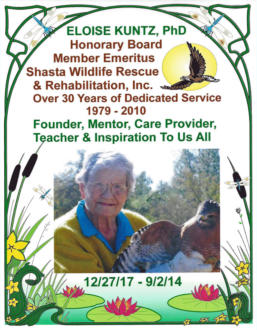

Award presented to Founding Member Eloise Kuntz – September, 2010. Eloise was born in Butte, Montana to Frank & Frankie Kuntz and grew up in Seattle, Washington, where she graduated from Washington State University with a masters in zoology and also earned a doctorate in biology from Brown University. Her career included teaching at Vasser College and work in biomedical research with Ethicon and Michigan State University. Eloise retired in 1982 and moved to Redding, CA.

When Eloise started volunteering with Shasta Wildlife, it was located in a modest facility owned by Haven Humane Society on Placer Street in Redding. Along with Tina Thorne and Renee and Jim Miller, these pioneers began the important work that formed the foundation of our current program.
Long time volunteers still fondly remember Eloise providing them with hands-on instruction in effective rescue, rehabilitation and release of injured and orphaned wildlife. Specializing in raptor care, Eloise continued to provide critical care and training until several years before her passing. In her later years she continued to serve as a Board Member Emeritus and also continued to provide guidance to our younger volunteers.
For many decades Eloise also pursued her passion for wildlife photography traveling to the North and South Pole, Madagascar and other remote parts of the world. The walls of her home were filled with spectacular photographs from these journeys. Her Master’s degree in zoology and PhD in physics and biochemistry provided her with many tools in her passionate observation and care of wildlife. A true pioneer in her many pursuits, Dr. Eloise Kuntz provided invaluable training and guidance to countless individuals during her many years of service.
A memorial service for Eloise was held in her home in Redding after her passing in the Fall of 2014. Many

long time volunteers, colleagues from Fish and Wildlife as well as family members shared fond memories of Eloise. Her family graciously donated one of her framed photographs from one of her wildlife expeditions to Shasta Wildlife Rescue to be sold in a fund raiser. Raffle tickets for this wonderful example of Eloise’s work were sold in 2015 at the April 4th Open House and Baby Bird Shower, the May 28 Annual Meeting and the October Salmon Festival. Funds raised were used for the care of injured and orphaned wildlife in memory of Eloise. She is survived by her nephew, Lloyd Prentice (Laurie) and niece Dawna Brown (Randy) and their families.
Founding Member Tina Thorne
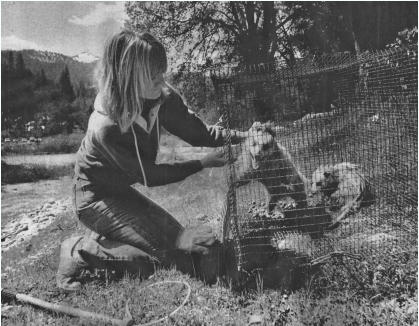
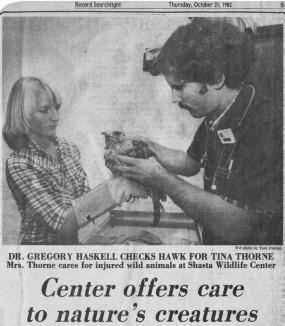
The following interview with Shasta Wildlife’s first Director, Tina Thorne appeared in Redding’s Record Searchlight, Thursday, October 21, 1982 (see photo, above right). Her words of wisdom still apply today, 34 years later as dedicated volunteers with SWRR continue to rescue, rehabilitate and release injured and orphaned wildlife and to educate the public.
CENTER OFFERS CARE TO NATURE’S CREATURES by John Crowe, Redding Record Searchlight, 1982
There is nothing cute and cuddly about a rough-legged hawk. Talons can crush bones and rip skin. The most powerful hooked beak might easily snatch an errant finger. So perhaps Sheba, now in the care of Tina Thorne, is an appropriate symbol for Shasta Wildlife Rescue, a group of volunteers dedicated to the rescue, rehabilitation and release of wild animals. Mrs. Throne is the director of the organization. The bird is suffering from a malady called bumble foot, a swelling of the pads, which it suffered when it was hit by a car. Like other animals that come to Shasta wildlife Rescue, the bird will be returned to the wild if it mends properly.
The emphasis on release is important. Shasta Wildlife Rescue is not in the business of creating pets, Mrs. Thorne said. While there is probably little temptation to make a pet of a hawk or other predators, the same cannot be said for a young jackrabbit a songbird nestling or a fawn. The fact is, Mrs. Thorne said, all are wild animals that should be free if at all possible. Nor is the notion strictly a philosophical one. It is illegal to possess any wild animal in California without a permit from the Department of Fish and Game, she noted.
Shasta Wildlife Rescue began two years ago, in the cramped space of the Carter House Science Museum in Redding, has since evolved into a network of volunteers who keep a variety of wild animals at their homes or property for rehabilitation. Mrs. Thorn said the animals usually have encountered the same obstacle: man. Whether it’s an animal that has been injured on the road, a nestling mauled by the family cat or a bird rendered flightless by a shotgun blast that injured but didn’t kill, man is nearly always directly or indirectly responsible for the animal’s predicament, she said. Shasta Wildlife Rescue represents one effort to balance the equation.
There is nothing romantic about the care and feeding of injured orphaned wild animals. “It takes a lot of dedication to feed a young opossum every two hours all through the night or to force feed a nestling,” Mrs. Thorne said. Finding the proper foods is no easy matter, either. Some animals have particular dietary requirements. The rough-legged hawk, for example, ideally needs small mammals or birds, complete with bones and feathers or fur – not the sort of thing you find in the local supermarket. There is also the certain knowledge that some animals brought to Shasta Wildlife Rescue volunteers are not going to survive.
It may be that the injuries are so severe that the animal ultimately perishes. It may be that the animal has been left too long in the hands of a well-meaning but uninformed person who knows little of its dietary or habitat needs. Even in the experienced hands of someone like Mrs. Thorne, chances of survival are often dicey because little is known about the particular requirements of wild animals. “There just isn’t the information,” Mrs. Thorne said, pointing to a single-volume reference text prepared at the University of California at Davis that is among the few sources.
But through it all, dedicated volunteers like Mrs. Thorne persist, with the assistance of the professional community of veterinarians and biologists. She candidly admitted that Shasta Wildlife Center is in need of more financial support. Membership is $7.50 a year for an individual or $15 for a family. Mrs. Thorne said the group expects to approach the county for some of the funds collected from poaching fines. In her mind, the wildlife of Northern California is a public possession. “It’s our wildlife”, she said.
Contributors Barbara and Bob Cordray
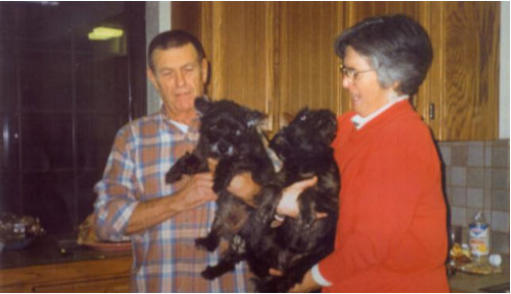
Prior to moving to North State, Barbara Cordray taught kindergarten for 25 years in Escondido while husband, Bob, successfully created two comic strips, “Smidgens” and “Alex In Wonderland.” When the Cordrays retired, they came to the Redding area to be close to family and to begin a new phase of their lives that revolved around a special connection with nature and wildlife.
The Cordrays always had a special attachment to animals – from their dog, Pepper to their pampered mules, Joseph and Isaac, to their barn cat. Once settled on their 30 acre Kitty Hawk property, the Cordrays kindled their love of nature. A pond set amidst trees and meadows provided the perfect setting for their special connection with wildlife.
Barbara passed in January of 2005, Bob in August of 2006. The mules have found a great home with lots of love and acreage and thanks to one of Shasta Wildlife’s volunteer’s, the Cordray’s beloved dog, Pepper, spent the rest of her years leading a charmed life with a beloved family. With their generous support to Shasta Wildlife Rescue and Rehabilitation, the Cordray legacy will live on.
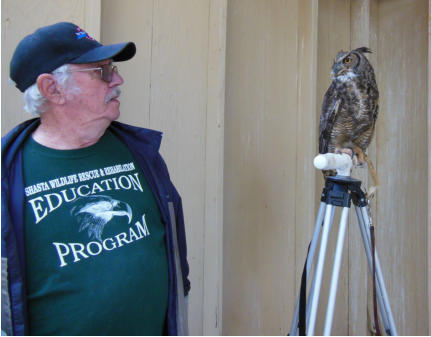
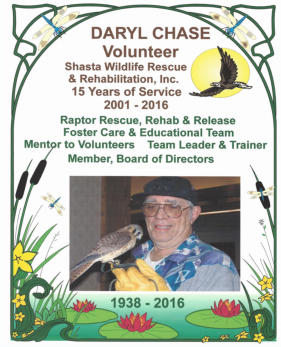
Daryl Chase, a volunteer with SWRR from 2001 to 2016, passed away at age 78 on March 14. During his fifteen years of exemplary voluntary service with us, Daryl was always there when needed in the rescue, rehabilitation and release of injured wildlife. Specializing in raptor s, for many years Daryl chaired the Raptor Rescue Team, mentoring volunteers and rescuing countless injured wildlife. He volunteered thousands of hours, selflessly serving in whatever capacity was needed. Over his years of service, Daryl provided foster care for injured raptors, housed and cared for educational team raptors, served on the Education Team, as a Team Leader and trainer and on Shasta Wildlife’s Board of Directors. Until recent years due to declining health, Daryl’s beloved wife, Lucretia also volunteered by his side, providing many years of loyal and caring service.
Daryl’s last rescue is a fitting tribute to his everlasting devotion to raptor rescue, rehabilitation and release. He was on his way home after releasing a hawk in Burney when he came upon a group of people pulled over on the side of the road. There was a bald eagle down so Daryl picked it up and brought it home for emergency care. After being evaluated by our local veterinarians, it was transferred to the UC Davis Raptor Center for specialized care and rehabilitation. Shortly after Daryl’s passing, the bird made a miraculous recovery and was released by our volunteers at the site where it had been rescued. Within five minutes of the release, four additional adult bald eagles were seen circling in the sky overhead and the eagle was reunited. This bittersweet memory of Daryl’s last successful rescue will undoubtedly inspire countless future volunteers.
A March, 2016 short video of Daryl with Kehwani, one of his owls. Courtesy of Jessica Skropanic from the Record Searchlight.
In Memory Of Dr. Eddie “Doc” Troop
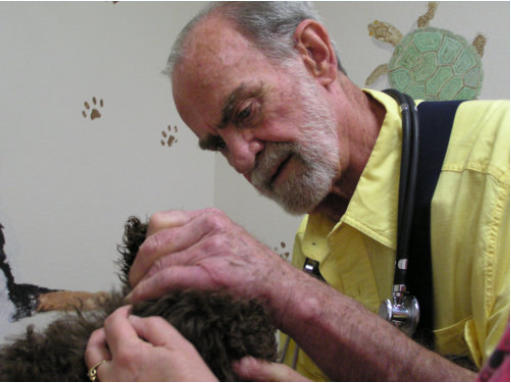
SWRR mourns the loss of Dr. Eddie Troop, who passed away July 8, 2012 at age 81.
In 1965, Dr. Eddie Troop joined the staff of Redding Veterinary Clinic. Founded in 1947 by Dr. Connie Ferreira, Redding Veterinary Clinic was the first animal hospital in Redding and all of Shasta County. In 1968, Dr. Troop took over the practice from Dr. Ferreira. Until his retirement in 2001, “Doc” and wife, Linda ran and grew Redding Veterinary Clinic. In 2001, Dr. Gary Bond took over the practice from Dr. Troop, who continued to provide animal care to Redding and Shasta County. From 2001 until 2011,“Doc” provided part time contract relief work, thereby maintaining a connection with many long time patients and their families.
Dr. Troop was a supporter of Shasta Wildlife Rescue and Rehabilitation from its’ inception. Even before our existence, he provided essential services to local fish and wildlife. Judy Justus, who has worked at Redding Veterinary since 1981, has vivid memories of his passion and commitment to wildlife. “He took care of anything and for everything they brought in . . . he was always available,” says Judy. She remembers “Doc” working closely with Eloise Kuntz, a founder of SWRR. “He really respected Eloise. He really liked the raptors, they were his favorites, he thought they were so amazing!” In the early days, “there was no one else around that treated birds.“Doc” was basically a country doctor. He liked the people and he liked the animals.”
In the mid 1990’s, Doctor Troop and wife Linda were frequent participants in SWRR’s training sessions, always willing and supportive. In the years that followed, they continued to be supportive of our programs, always available to answer questions and provide guidance to volunteers.
Redding Veterinary Clinic
4275 Westside Rd.
Redding, California 96001
(530) 243-8335
Dr. Gary Bond and his wonderful staff from the clinic continue to provide veterinary services to Shasta Wildlife’s rescued animals. Their dedication is much appreciated by all.



